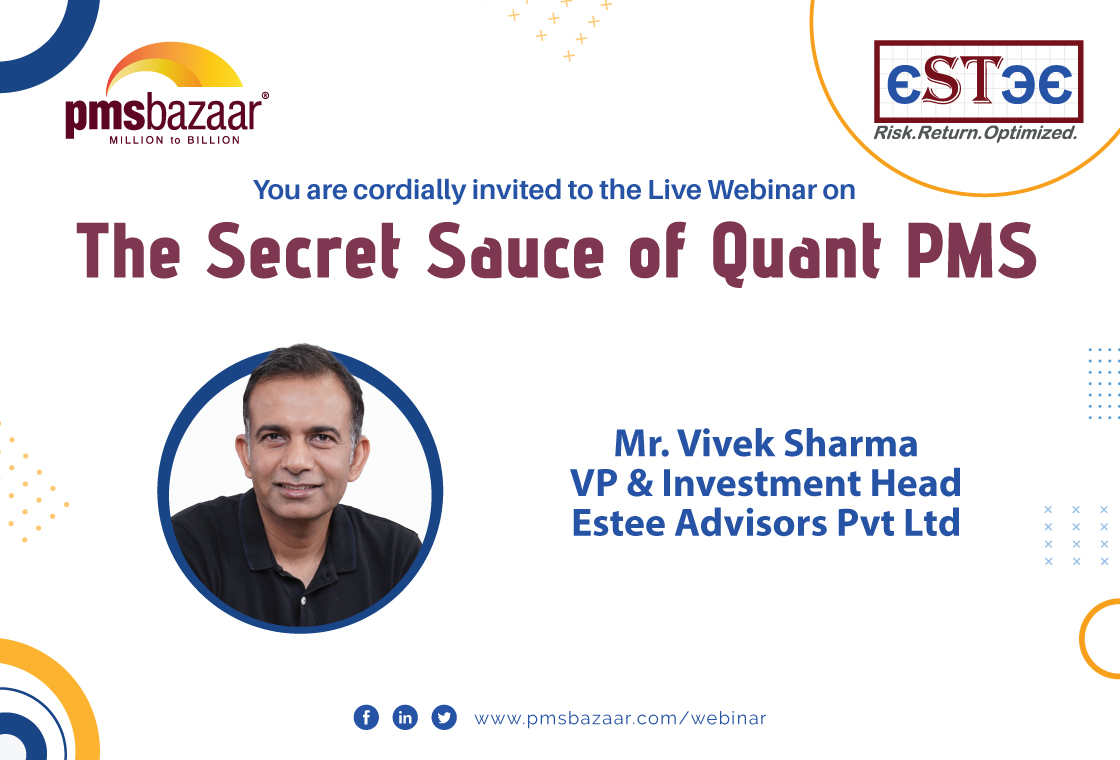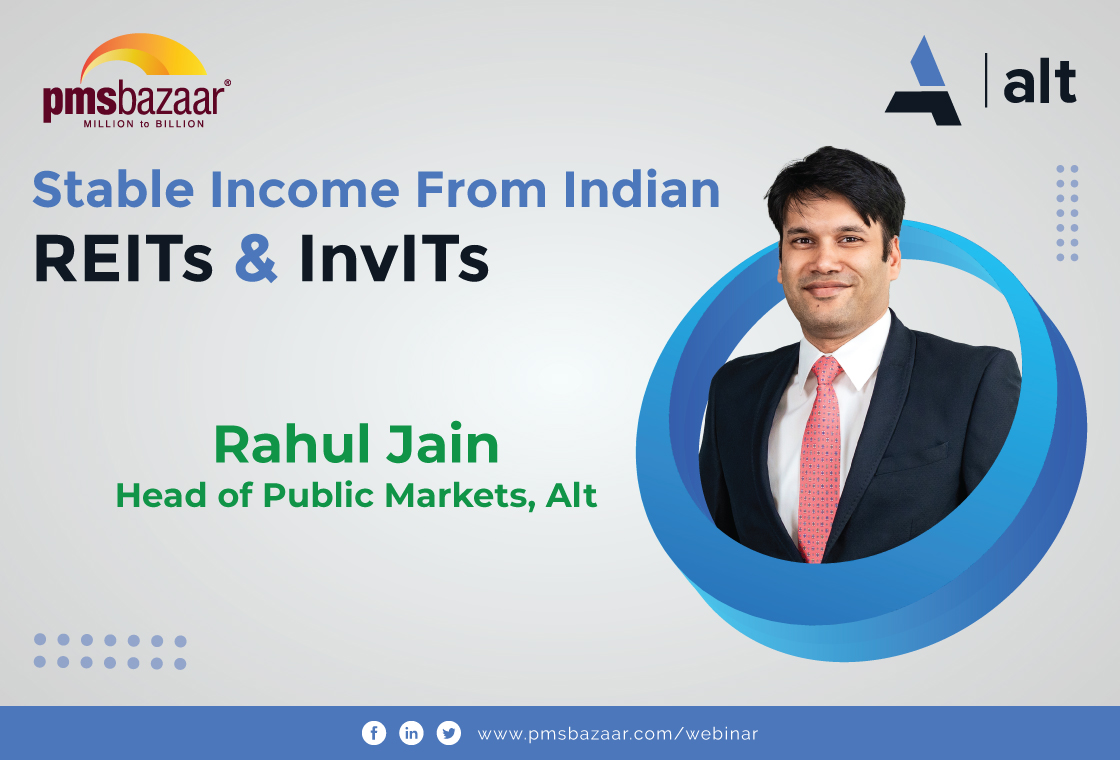PMS Bazaar recently organized a webinar titled “The Secret Sauce of Quant PMS,” which featured Mr. Vivek Sharma, VP & Investment Head, Estee Advisors Private Limited.

The webinar blog covers insights from Mr. Sharma, which includes his journey into quantitative investing and his firm’s systematic, data-driven strategies. It highlights Estee’s unique approach to factor timing, risk management, and portfolio construction using in-house analytics. The blog also delves into their standout products like I-Alpha and Long Alpha, while addressing market regimes, Specialized Investment Funds (SIFs), and audience queries.
Key aspects covered in this webinar blog are
- Embracing the quant revolution
- Risk, regulation, and market confidence
- Investment philosophy: Adaptation over prediction
- Alpha, volatility, and the information ratio
- Factor conflicts and market regimes
- The consistency of I-Alpha: A market-neutral strategy
- Robust risk systems and portfolio synergy
- The art of factor timing and market regimes
- The engine room: In-house analytics and data
- Managing risk: Turnover, drawdowns, and recovery
- Factor sensitivity and strategy
- Momentum and size explained
Summary: Mr. Vivek Sharma shared his journey from IIT Kharagpur to leading quantitative investing at Estee. He discussed systematic strategies, factor timing, and the power of data-driven decisions. Highlighting proprietary tools, market regime analysis, and disciplined risk management, he explained Estee’s strengths in momentum, size, and multi-factor portfolios. Sharma also introduced I-Alpha and Long Alpha strategies, emphasizing resilience, performance, and low correlation. He addressed Specialized Investment Funds (SIFs) and urged cautious optimism. The session concluded with detailed audience Q&A and valuable investing insights.
Mr. Vivek Sharma started by sharing his journey and perspectives on the evolving investment landscape. His experiences, drawn from years in trading and data-driven strategies, offer a rare window into the workings of algorithmic investing and market adaptation.
From IIT to Wall Street
Mr. Sharma’s passion for markets began during his engineering days at IIT Kharagpur. Fascinated by the market’s complexity, he tracked stocks using a virtual portfolio and soon realised investing was more than a passing interest. After a short stint in the tech industry, he joined Futures First, where he spent ten transformative years training traders and refining his understanding of global markets. He credits this period for instilling discipline and a foundation in trading, though transitioning to the Indian market and quantitative investing required “unlearning” some habits of discretionary trading.
Embracing the Quant Revolution
Over the past decade, Mr. Sharma observed the rise of digitalisation and saw an opportunity in systematising investment strategies. Moving away from intuition-based trades, he embraced quantitative investing, which he described as “a wonderful journey.” His firm’s approach is heavily data-driven, incorporating both technical and fundamental inputs. Approximately 70% of their focus is on technical indicators, with the remaining 30% drawing from fundamentals—all framed within a macroeconomic context.
Risk, Regulation, and Market Confidence
In response to SEBI’s recent scrutiny of global quant firms, Mr. Sharma viewed regulatory action as a positive. While such actions may cause short-term disruption, he believes they ultimately build market confidence by reinforcing transparency and fair play.
He also touched on risk management, citing their use of a “cone of confidence” framework. This involves analysing 15 years of data to estimate performance boundaries. If returns fall below the worst-case scenario, it triggers a deep review of assumptions, signals, and data quality. Portfolios are rebalanced monthly, striking a balance between responsiveness and transaction efficiency.
Investment Philosophy: Adaptation Over Prediction
Unlike traditional strategies that aim to forecast markets, Mr. Sharma’s firm prioritises adaptation. He emphasised that reacting to new data is more practical than predicting geopolitical or economic shocks. Their algorithms are built to adjust as new market realities unfold, allowing for agility without emotional decision-making.
Alpha, Volatility, and the Information Ratio
Balancing returns and risk are core to their methodology. Mr. Sharma explained the focus on optimising the information ratio, which measures how consistently returns outperform a benchmark. Their portfolios typically consist of 80–100 stocks, diversified across factors like momentum, quality, growth, and low volatility. By dynamically adjusting factor weights based on prevailing regimes, they aim to maximise long-term consistency.
Factor Conflicts and Market Regimes
Conflicting signals such as high momentum but weak quality—are addressed using a multi-factor approach. Market regimes are identified first, then the most relevant factors are prioritised. This systematic method ensures decisions are clear and data-backed, avoiding confusion and emotional bias.
The Consistency of I-Alpha: A Market-Neutral Strategy
A standout in Estee’s offering is I-Alpha, a market-neutral strategy running successfully for 17 years without a single losing month. Based on index arbitrage between the Nifty and a synthetic version built from its components, I-Alpha profits from price convergence at expiry. Combined with microsecond-level execution, this ensures reliable gains regardless of market direction.
Robust Risk Systems and Portfolio Synergy
I-Alpha’s success is underpinned by a three-tier risk system: fund-level thresholds, strategy-level controls, and operational safeguards. It is designed for conservative investors, while Long Alpha, with its 30% CAGR, suits growth seekers. The two strategies are uncorrelated, allowing investors to combine them for better risk-adjusted returns. Mr. Sharma likens Long Alpha to an “accelerator” and I-Alpha to “brakes,” balancing growth with stability.
The Art of Factor Timing and Market Regimes
When asked about timing factors to suit market conditions, Mr. Vivek Sharma explained that their approach revolves around identifying market regimes. By analysing prevailing trends, they determine which investment factors such as momentum, quality, or value—are most likely to perform well. This systematised method forms the basis of their factor timing strategy, ensuring portfolios stay aligned with current market dynamics.
The Engine Room: In-House Analytics and Data
In response to a question about analytics, Mr. Sharma revealed that while they use external data providers like Bloomberg and CMIE, all their analytics tools and software are developed internally. This proprietary framework enhances control, flexibility, and data accuracy—key ingredients in building strong, quant-driven portfolios.
What Sets Estee Apart
Mr. Sharma pointed out two clear differentiators for Estee’s quant products. First, their high-frequency execution systems offer a real-time trading edge, allowing faster response to market signals. Second, their multi-factor research approach is informed by insights not just from India but also from markets like the US, Brazil, and China. With over 130 factors, Estee builds robust portfolios backed by global intelligence.
He added that their consistent focus on quant investing without venturing into discretionary strategies or hedging strengthens their credibility. Unlike peers who dilute their models by stepping outside their expertise, Estee maintains discipline and precision.
Managing Risk: Turnover, Drawdowns, and Recovery
Mr. Sharma noted their portfolios typically witness a 300–400% annual turnover, translating to average holding periods of three to four months. On drawdowns, he clarified that stock-specific stop losses or profit targets don’t show consistent long-term benefit. Instead, their monthly rebalancing strategy has proven more effective.
While quant strategies may underperform in bear markets, Sharma stressed their quicker recovery during market rebounds. They often deliver 20–30% alpha in strong markets and match benchmark losses in downturns, highlighting the importance of resilience.
SIFs: A New Chapter
With plans to offer their strategies via Specialized Investment Funds, Mr. Sharma expressed optimism. SIFs, he said, allow firms with proprietary trading and long-short capabilities to deliver “differentiated offerings.” However, he urged investors to evaluate SIFs over 1–2 years before investing heavily.
Factor Sensitivity and Strategy
In regime shifts, growth, size, and momentum shine in bullish markets, while value, quality, and low volatility stand out in corrections. Mr. Sharma explained that systems must balance sensitivity to shifts—too sensitive risks false signals, while less sensitivity can improve stability.
Momentum and Size Explained
Finally, he defined momentum as the tendency of winners to keep performing. For instance, picking the top 20 stocks by past six-month returns often yields results. Regarding the size factor, he noted that small-cap stocks offer better alpha but with higher risk.
Mr. Vivek Sharma covered all the topics mentioned above in-depth and answered questions from the audience toward the end of the session. For more such insights on this webinar, watch the recording of this insightful session through the appended link below.
Get access to rich data and analytics of PMS & AIF by subscribing to us. Join the 75000+ investors & experts: Subscribe NOW
Recent Blogs
.jpg)
Passively Active Investing — A Modern Investor’s Lens on ETF-Based PMS
PMS Bazaar recently organized a webinar titled “Passively Active Investing — A Modern Investor’s Lens on ETF-Based PMS,” which featured Mr. Karan Bhatia, Co-Founder and Co-Fund Manager , Pricebridge Honeycomb ETF PMs. This blog covers the important points shared in this insightful webinar.

Spot the Trouble: Red Flags in Equity Investment Analysis
PMS Bazaar recently organized a webinar titled “Spot the Trouble: Red Flags in Equity Investment Analysis,” which featured Mr. Arpit Shah, Co-Founder & Director, Care Portfolio Managers. This blog covers the important points shared in this insightful webinar.

Long-Only AIFs Rebound Sharply in October; Long-Short Strategies Lag Despite Lower Volatility
106 long-only AIFs averaged 3.68% vs 32 long-short AIFs at 2.7%; only 24–31% of funds beat key indices

Markets log strongest monthly gains in 7 months; PMS performance turns near-uniform in October
Nifty 50 TRI gained 4.62%, BSE 500 TRI rose 4.27%; 415 of 427 equity PMSes ended positive

How SMEs are Shaping India’s Investment Landscape?
PMS Bazaar recently organized a webinar titled “How SMEs are Shaping India’s Investment Landscape?” which featured Mr. Shrikant Goyal, Fund Manager, GetFive Opportunity Fund.

Stable Income from Indian REITs and InvITs
PMS Bazaar recently organized a webinar titled “Stable Income from Indian REITs and InvITs,” which featured Mr. Rahul Jain, Head of Public Markets, Alt.

5 Key Considerations Before Investing in AIFs in India
Alternative Investment Funds (AIFs) have emerged as a compelling option for sophisticated investors seeking diversification and potentially superior returns. But venturing into AIFs requires a clear understanding of their unique characteristics that go beyond simply knowing what they are and their categories.

How AIF can help in diversification?
Traditionally, Indian investors have relied on a mix of stocks and bonds to build their wealth. While this approach offers diversification, it can still leave your portfolio vulnerable to market fluctuations. Enter Alternative Investment Funds (AIFs), a dynamic asset class gaining traction for its ability to unlock diversification beyond the realm of conventional options.

